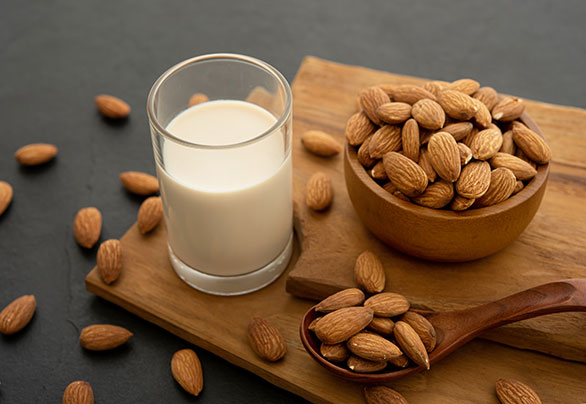
Plant-based dairy alternatives have surged in popularity, with a growth rate of 17.2% going into October of 2020. With soy, hemp, almond, oat, coconut, cashew, and rice milk among the most in-demand alternatives, consumers are ditching dairy for healthier, more sustainable food and beverage alternatives. From coffee creamers, yogurt, cheeses, ice cream, and more, adopting a dairy-free lifestyle has never been easier. This growth is set to continue over the next decade as Global Market Insights predicts the plant milk market to achieve over an 11% CAGR from 2020 to 2026, bringing the market value to USD 21 billion. So what exactly spawned the popularity of plant-based milk, and what does the future hold for this market?
Key Drivers
The growing demand for milk alternatives correlates with a rise in veganism. Plant-based diets have increased by 300% in the last 15 years, as more than 9.6 million Americans identify as vegan in 2019, according to a study by Ipsos. Veganism’s popularity may spawn from concerns over the environment, animal welfare, health benefits, and even taste. The appeal of plant-based foods is not limited to vegans. More than 40% of North American consumers are incorporating more vegan ingredients into their diets, as stated by Health Careers.
2. Health Benefits
Plant-based products have a myriad of health benefits, appealing to vegans and non-vegans alike. In an IFIC Food and Health Survey, 43% of surveyed consumers claim that a product with a description of plant-based would likely be the healthiest compared to other options. With milk alternatives having fewer calories and less fat than cow milk, many consumers have made the switch to aid weight loss. With no inflammatory ingredients, lactose, or carcinogenic hormones, plant-based milk products are easier to digest with minimal health effects. In terms of nutrients, dairy alternatives are rich with protein, fatty acids, and minerals to support a healthy body. With rising levels of lactose intolerance and milk allergies, plant-based alternative products allow consumers to enjoy a wider variety of foods without fear of a reaction. With several options to choose from, there is a non-dairy alternative to satisfy every taste and nutritional preference.
3. Environment/Animal Welfare
Concerns over the environmental impact of the dairy industry and animal welfare have also reduced milk consumption. Though all milk alternatives have different effects on the environment, non-dairy milk significantly reduces emissions, land use, and water use. The resources needed to sustain dairy farms such as animal feed and pastures use substantial amounts of energy and are harmful to the environment. According to the BBC, 58% of greenhouse gas emissions come from animal products. Cows, in general, produce large amounts of methane, further emitting greenhouse gases into the atmosphere. Plant-based milk requires fewer resources to make, providing consumers with a greener alternative.
Increased ethical concerns amongst consumers regarding the inhumane treatment of dairy cows has also decreased milk consumption. With poor animal living conditions on factory farms, including limited grazing, premature slaughter, and increased physical issues of cows, many consumers have turned to plant-based options in support of animal welfare. In a survey conducted by Statista, 41% of consumers believe that plant-based milk is more humanely produced than traditional dairy.
Drawbacks of Alternatives
Despite its rapid growth, plant-based milk alternatives face many challenges. For one, non-dairy products tend to cost more than traditional dairy. According to the New York Post, almond and soy milk cost almost twice as much as cow’s milk, with oat milk costing 2.5 times as much. Price volatility remains one of the most prevalent issues in the plant-based alternatives market. The lack of available raw materials and high turnover tax rates result in higher production costs compared to cow’s milk, driving up prices.
Another issue in the plant-based milk alternative market stems from its lack of nutrients. With the varying nutritional profiles of plant-based milk, not all products have fewer calories or comparable vitamins, minerals, and protein to cow’s milk. Added flavoring and sweeteners to plant-based dairy products may also decrease its nutritional value. In addition to consumer concerns with nutritional value, plant-based milk alternatives risk cross-contamination when produced or served alongside non-vegan products.
What the Future Holds
Increasing awareness and product innovation will continue to drive the non-dairy craze in the food and beverage industry. Plant-based milk is on track to dominate the market. In 2019, plant milk made up 14% of the entire milk category, growing at a rate of 5%, compared to .1% for cow’s milk, according to the Plant-Based Foods Association. As more businesses harness the popularity of plant milk in their products, the market will continue to expand, providing consumers with alternatives to the foods and beverages they love.
We have used eyes4research for a number of internal product and marketing projects. We have found their services to be professional, accommodating and responsive. The quality of their audience is top notch and their data is very reliable.
The team at Eyes4Research provided us with quick answers to complicated questions. Their personal support allows us to launch surveys at short notice, while the online dashboard makes it easy to analyze responses and visualize the results.
After working with the team from eyes4research, we decided to move all our survey research to online, and now we are able to conduct research fast, less expensive, and with more accurate samples than ever in our business history.
Eyes4Research provided outstanding support managing a large scale survey we conducted in the United Kingdom. The team works with high professional standards, competency and provided timely delivery throughout the project.
The team at Eyes4Research worked with me not only for getting consensus on the presentation, but also accommodated my inclusion criteria without hesitation. Additionally, I loved the dashboard and the features available for reporting.